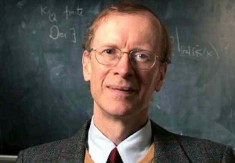| Andrew Wiles | |
|---|---|
 |
|
| Mathematician | |
| Born | April 11, 1953 (at age 60) Cambridge, England |
| Nationality | British |
Sir Andrew Wiles is a British mathematician. He is best known for providing a proof of Fermat’s Last Theorem, something which had eluded science for more than three centuries. Wiles is a specialist in number theory, and he is a research professor at the University of Oxford. He was knighted in 2000 in recognition of his achievements, and Oxford’s Mathematical Institute building is named in his honor.
Wiles has also received many other awards and honors, including a plaque presented in 1998 because he was slightly too old to receive the Fields Medal, the most prestigious prize in mathematics, but one restricted to the under-40s.
Early Life
Wiles was born on April 11, 1953, in Cambridge, England. He had an academic background from the start: his father held the post of Oxford’s Regius Professor of Divinity, and later worked at Ridley Hall at Cambridge as the college’s chaplain.
Andrew was educated in Cambridge, first at King’s College School and later at The Leys. His fascination with Fermat’s Last Theorem dates back to his school days. When he was just ten, he found a book about it in his local public library. Even at that age, he could understand the theorem itself, which states that for an equation in which a, b, and c are raised to the same power, n, the sum of the first two, cannot equal the third for any integer above two.
Wiles’ attention was caught by the fact that such a simple-sounding equation remained unsolved after more than 300 years, despite Pierre Fermat’s famous claim that he had found a proof in the 17th century – but had no space in the margin of his notebook to set it down.
Nevertheless, Wiles quickly came to realize that his mathematical knowledge was not sufficient to solve the problem and for more than two decades, it lay dormant in his mind. In 1986, however, he noted the proof of the related epsilon conjecture by Ken Ribet. At the age of 33, Wiles resolved to restart his work on Fermat’s Last Theorem.
Professional Career
 By the time he returned to Fermat’s Last Theorem, Wiles had become a respected mathematician. He had obtained his bachelor’s degree from Oxford in 1974, and six years later earned a Ph.D. at Cambridge. He then moved to the United States, spending a short period at New Jersey’s Institute for Advanced Study before accepting a job at Princeton as a professor.
By the time he returned to Fermat’s Last Theorem, Wiles had become a respected mathematician. He had obtained his bachelor’s degree from Oxford in 1974, and six years later earned a Ph.D. at Cambridge. He then moved to the United States, spending a short period at New Jersey’s Institute for Advanced Study before accepting a job at Princeton as a professor.
In the mid-1980s, he spent several years in France, at one point acting as a Guggenheim Fellow. In 1988, he returned to Oxford for a short spell before going back to Princeton. He remained based in the U.S. for most of his subsequent career, but eventually returned, once again, to Oxford in 2011.
Graduate Work and Research
Wiles produced some significant research during his graduate work. As far back as 1975, under the guidance of John Coates, he worked on the Iwasawa theory and the complex multiplication of elliptic curves. With Barry Mazur, he came up with a generalization of a principal conjecture of the Iwasawa theory that extended its application from rational to totally real fields.
By 1986, having followed the progress of the likes of Ken Ribet, Jean-Pierre Serre, and Gerhard Frey, Wiles became convinced that it was possible to prove Fermat’s Last Theorem. He was particularly well placed to do so, as the modularity theorem he needed to employ was itself connected with the study of elliptic curves.
Proving Fermat’s Last Theorem
In the 1980s, most mathematicians felt that Fermat’s Last Theorem, despite its importance, was extremely hard to prove. Coates himself used the word “impossible” at one point when discussing the idea of proving it. Wiles himself was among a small minority who believed that a proof was realistic.
For more than six years, he spent all the time he had available for research on this one problem. He was very careful not to let anyone else know what he was doing, and told only his wife the full story of his research. To cover his tracks, he intermittently released carefully chosen snippets of his earlier work.
Wiles Goes Public
At a conference in Cambridge in 1993, Wiles went public for the first time, causing a sensation which reached even the general public. However, a flaw in his reasoning was demonstrated a few months later, and for more than a year he was unable to make the necessary adjustments that would rescue his achievement.
He admitted that he was close to abandoning the search by September 1994, when he finally realized how to get around the flaw in his original paper. Again, the world’s media crowded in. Wiles was interviewed by the BBC and the resulting program was shown on PBS in the United States.